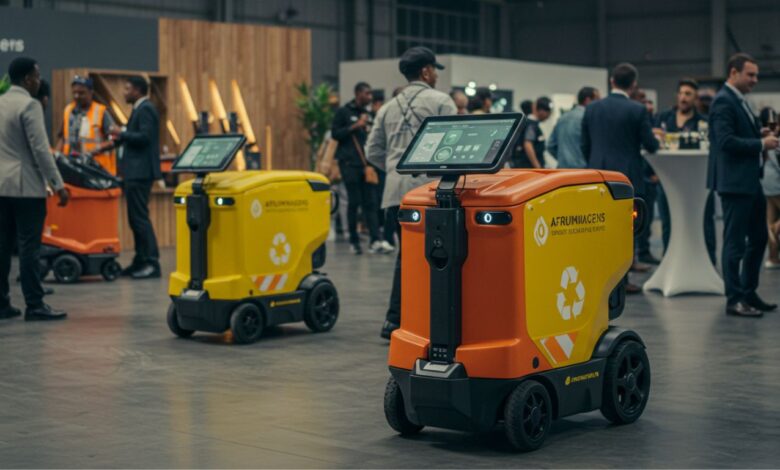Afruimwagens Smart Clearing Carts for Hospitality & Beyond
How Afruimwagens Improve Efficiency and Hygiene

Afruimwagens are essential tools behind the scenes in service settings. Whether in restaurants, hotels, schools, or event venues, they help staff clear tables, transport trays, and move dirty dishes with speed and order. The word comes from Dutch, meaning “clearing carts,” and over time afruimwagens have evolved to be more durable, hygienic, efficient, and suited for many environments.
What Are Afruimwagens — Definition & Origins
Afruimwagens are mobile carts designed to collect and transport used dishes, trays, cutlery, glasses, and sometimes food waste from service areas to dishwashing or storage zones. Staff push or roll these carts rather than carrying items by hand.
The term is Dutch. Literally “afruim” means “to clear away,” and “wagens” means “carts” or “wagons.” In English-speaking contexts, equivalents include “serving carts,” “clearing trolleys,” “bussing carts,” or “dish collection carts.”
Historically, afruimwagens were simple wooden or metal trays mounted on castors, used in cafés or large dining halls. Over time, design refined to emphasize hygiene, durability, quiet movement, and multi-shelf or multi-compartment forms.
History of Afruimwagens — Evolution Over Time
Afruimwagens grew from basic carts in older hospitality or farming contexts. Early versions were often open wooden or metal frames with flat shelves, used in informal settings.
With increasing standards of hygiene, space efficiency, and guest expectations in service industries (restaurants, hotels, events) the design evolved: stainless steel frames, enclosed or semi-enclosed compartments, multiple shelves, fitted wheels, and later, features to segregate dirty, clean, and waste items.
Also, demand from high-volume environments (banquets, schools, hospitals) raised expectations about capacity, maneuverability, and safety. Manufacturers responded with heavier load capacities, ergonomic handles, quieter wheels, antimicrobial surfaces, and designs suited for narrow corridors or tight spaces.
Types of Afruimwagens — Models and Use Cases
Different settings need different kinds of afruimwagens. Here are common types:
-
Standard Multi-Shelf Open-Shelved Carts
Two or three open shelves to stack trays, plates, and glasses in busy cafés or small restaurants. -
Closed-Sided or Enclosed Carts
With panels or covers to hide dirty items from guests, for upscale restaurants or presentation-sensitive settings. -
Tray-Return / Self-Service Models
Designed for cafeterias where customers deposit trays directly into a slot or rack built into the cart. Reduces labor and organizes items from consumer side. -
Heavy-Duty Industrial Carts
Steel or reinforced frames, larger load capacity, built for banquet halls, hotels, hospitals, or high-volume catering services. -
Modular & Waste-Separation Carts
Units with built-in bins or compartments to separate waste, compost, recyclables, or to segregate different types of dishes (cutlery, glassware, etc.). -
Compact / Narrow-Space Carts
Slim designs for tight corridors or cafés with limited space, or to use in room service situations.
Key Features of Afruimwagens — What Makes Them Practical
To be truly useful, an afruimwagen usually includes several important design elements:
-
Durable Materials
Stainless steel (for strength, hygiene, rust resistance), high-quality plastics (for lighter weight and noise reduction), sometimes aluminum. -
Smooth, Reliable Wheels & Braking
Castors or wheels designed for quiet movement, ability to navigate over tile, wood, or sometimes outdoor surfaces. Brakes to prevent unintended rolling. -
Multiple Shelves / Compartments
To separate glasses, plates, trays; possibly bins for waste. Helps prevent breaks or contamination. -
Ergonomic Handles & Stability
Comfortable to push; well-balanced load to avoid tipping; reinforced frames -
Easy Cleaning / Hygiene Design
Rounded edges, surfaces easy to wipe, enclosed parts where needed, resistant to stains or corrosion. -
Load Capacity & Size Options
Different sizes depending on number of covers, venue size; ability to carry heavy loads without structural failure. Aesthetic Considerations
Especially in upscale dining or visible areas: finish, panels that hide dirty items, polished surfaces, style congruent with décor.
Benefits of Afruimwagens — Why They Are Valuable
Using good afruimwagens yields multiple advantages:
-
Efficiency in Service
Staff can clear multiple tables or sections in fewer trips, accelerating table turnover and improving guest experience. Reduced Labor Costs & Fatigue
Moving items via cart instead of carrying by hand reduces staff strain and risk of injury; less downtime.Improved Hygiene
Controlled movement of dirty dishes, separation of waste, easier cleaning of cart surfaces helps reduce cross-contamination -
Enhanced Presentation & Guest Perception
Clean, organized removal of used items keeps dining areas neat; closed or aesthetically pleasing carts help maintain atmosphere. -
Space Optimization
Carts that fit narrow spaces, stacking shelves, compact footprint help maximize utility without blocking movement. -
Versatility Across Industries
Not just for hospitality—used in schools, hospitals, events, banquets; adaptable models serve many sectors.
Best Practices for Using Afruimwagens Effectively
To get the most from afruimwagens, businesses should consider:
-
Staff Training on loading, balancing, pushing safely. Proper stacking avoids accidents or damage.
-
Keeping Aisles Clear so carts move without obstruction; design layout to accommodate cart paths.
-
Regular Maintenance of wheels, frames, shelves; inspect for damage, clean surfaces to avoid grime buildup.
-
Choosing the Right Size & Capacity for your operation—too small slows service; too large may be hard to maneuver.
-
Selecting Materials that Fit Your Environment — stainless steel where hygiene is critical; plastic where noise or weight are concerns.
-
Using Waste Segregation Features if available – separate bins help with recycling and reduce mess.
-
Keeping Appearance in Mind when carts are visible to guests – using closed or partially enclosed modelshelps.
Industries Using Afruimwagens — Applications & Contexts
Afruimwagens are used in many settings beyond just restaurants:
-
Restaurants, Cafés, Bars — clearing tables, moving dirty dishes to kitchen.
-
Hotels & Banquets — large-scale clearing for events, room service, buffets.
-
Schools, Universities, Cafeterias — high volume dining, tray return, waste sorting.
-
Hospitals & Care Homes — hygiene is critical; carts used for linens, dishes, utensils safely.
-
Event Venues & Conference Centers — fast clearing between sessions, servicing stands or breaks.
-
Retreat Centers, Camps, Campsites — mobile clearing where facilities are more distributed.
Innovations & Future Trends in Afruimwagens
These tools are evolving as demands and technologies shift:
-
Eco-friendly materials — recycled plastics, powder-coated metals, antimicrobial finishes.
-
Noise reduction — quiet wheels, vibration dampening for better guest comfort.
-
Modular & Flexible Designs — removable bins, adjustable shelves, convertible to different uses.
-
Automation & Smart Features — weight sensors, route optimization, possibly motorized or electrically assisted push/pull.
-
Hygiene-Focused Upgrades — UV coatings, antimicrobial surfaces, enclosed compartments to mask dirty items.
-
Custom & Aesthetic Options — tailor finishes, colors, panels to match brand or décor for visible service areas.
Challenges & Limitations of Afruimwagens
While highly useful, afruimwagens also come with considerations and potential drawbacks:
-
Initial Cost vs Scale — high-end models with many features cost more; small businesses may find it an investment.
-
Wear & Tear especially on wheels, joints, loading surfaces; maintenance is essential.
-
Maneuverability Issues in tight spaces or with heavy loads.
-
Hygiene Risks if cleaning is neglected or if waste separation is not used properly.
-
Design Trade-offs — open shelves are easier to load but less tidy; enclosed ones are tidier but may cost more or reduce quick access.
Sustainability & Afruimwagens
Sustainability is increasingly important in hospitality and service:
-
Reducing trips (one cart vs many hand carries) lowers energy and time costs.
-
Use of long-lasting materials means fewer replacements, less metal/plastic waste.
-
Waste separation features support recycling and reduce landfill burden.
-
Electric or assisted push/pull models reduce manual strain, potential use of renewable power.
Case Example — Afruimwagens in a Restaurant Setting
Imagine a mid-sized restaurant with 80 seats, two shifts per day. Without afruimwagens, servers carry plates back and forth, repeating trips to dishwashing. With afruimwagens:
-
Staff can collect dirty dishes from multiple tables in one trip.
-
Clean and dirty items can be separated on different shelves.
-
Time saved means faster table turnover, better satisfaction.
-
Less risk of items breaking or staff being injured carrying heavy loads.
-
More consistent presentation: visible carts reduce clutter.
FAQs About Afruimwagens
What materials are best for afruimwagens?
Stainless steel is most durable and hygienic; plastics are lighter and quieter; aluminum combines weight and strength.
How big should an afruimwagen be?
Depends on business size and layout. It must fit doorways and aisles but still carry enough to reduce repeated trips.
Are afruimwagens hygienic?
Yes if maintained correctly—surfaces cleaned, dirty items separated, closed models helpful, stainless steel or hygienic plastics preferred.
Do I need multiple afruimwagens?
In high-volume or multi-area operations (restaurants, banquets), yes; smaller venues may need just one or two.
Can afruimwagens be used outside?
Some are built for light outdoor use; stainless steel and weather-proof materials help; but mostly used indoors or under cover.
What is the lifespan of a good afruimwagen?
With good material and proper care, many last years; steel models often longer; parts like wheels may need replacement more often.
Conclusion
Afruimwagens may not be glamorous, but their role is vital. They are silent workhorses in hospitality and service industries, turning behind-the-scenes tasks into efficient, safe, and presentable operations. From simple clearing carts to advanced modular, hygienic, and even smart designs, afruimwagens show how focused design and practical innovation can make a big difference. For any business that serves guests, efficiency, cleanliness, and presentation matter—and a well-chosen afruimwagen brings all three.




